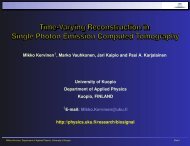USER'S GUIDE - Biosignal Analysis and Medical Imaging Group
USER'S GUIDE - Biosignal Analysis and Medical Imaging Group
USER'S GUIDE - Biosignal Analysis and Medical Imaging Group
- No tags were found...
Create successful ePaper yourself
Turn your PDF publications into a flip-book with our unique Google optimized e-Paper software.
2.2. Derivation of HRV time series 18Figure 2.2: Electrophysiology of the heart (redrawn from [26]). The different waveforms foreach of the specialized cells found in the heart are shown. The latency shown approximatesthat normally found in the healthy heart.sampling frequency of the ECG is less than 500 Hz, the errors in R-wave occurrence timescan cause critical distortion to HRV analysis results, especially to spectrum estimates [30].The distortion of the spectrum is even bigger if the overall variability in heart rate is small[38]. The estimation accuracy can, however, be improved by interpolating the QRS complex,e.g., by using a cubic spline interpolation [8]. It should be, however, noted that when theSA-node impulses are of interest there is an unavoidable estimation error of approximately3 ms due to fluctuations in the AV-nodal conduction time [41].2.2 Derivation of HRV time seriesAfter the QRS complex occurrence times have been estimated, the HRV time series can bederived. The inter-beat intervals or RR intervals are obtained as differences between successiveR-wave occurrence times. That is, the n’th RR interval is obtained as the differencebetween the R-wave occurrence times RR n = t n − t n−1 . In some context, normal-to-normal(NN) may also be used when referring to these intervals indicating strictly intervals betweensuccessive QRS complexes resulting from SA-node depolarization [44]. In practice, the NN<strong>and</strong> RR intervals appear to be the same <strong>and</strong>, thus, the term RR is preferred here.The time series constructed from all available RR intervals is, clearly, not equidistantlysampled, but has to be presented as a function of time, i.e. as values (t n ,RR n ). This facthas to be taken into account before frequency-domain analysis. In general, three differentapproaches have been used to get around this issue [44]. The simplest approach that havebeen adopted in, e.g., [2] is to assume equidistant sampling <strong>and</strong> calculate the spectrumdirectly from the RR interval tachogram (RR intervals as a function of beat number), seethe left panel of Fig. 2.3. This assumption can, however, cause distortion into the spectrumKubios HRV <strong>Analysis</strong>version 2.0 beta<strong>Biosignal</strong> <strong>Analysis</strong> <strong>and</strong> <strong>Medical</strong> <strong>Imaging</strong> <strong>Group</strong>Department of PhysicsUniversity of Kuopio, FINLAND





